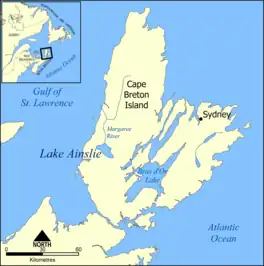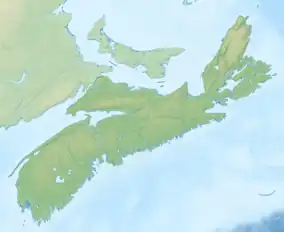| Lake Ainslie | |
|---|---|
 | |
 Lake Ainslie | |
| Location | Inverness County, Nova Scotia |
| Coordinates | 46°7′36″N 61°10′34″W / 46.12667°N 61.17611°W |
| Type | Glacial Lake |
| Primary inflows | Trout Brook |
| Primary outflows | Margaree River |
| Basin countries | Canada |
| Max. length | 20 km (12 mi) |
| Max. width | 7 km (4.3 mi) |
| Surface area | 57.4 km2 (22.2 sq mi) |
| Average depth | 5.75 m (18.9 ft) |
| Max. depth | 18 m (59 ft) |
| Water volume | 0.33 km3 (270,000 acre⋅ft) |
| Surface elevation | 57 m (187 ft) |
| Islands | none |
| Settlements | Municipality of the County of Inverness |
Lake Ainslie is the largest natural freshwater lake on Cape Breton. The Southwest Margaree River starts at the lake and empties into the Gulf of Saint Lawrence. The lake is approximately 20 kilometres (12 mi) long and averages 5 kilometres (3.1 mi) in width.[1]

The western shore of Lake Ainslie, looking north, at Hayes River, Nova Scotia.
It was formed during the Pleistocene, about two million years ago, when glacial outwash blocked the drainage of the valley of Loch Ban. It is underlain primarily by sedimentary deposits of the Horton and Windsor Formations, dating back about 350 million years.[2]
A number of bald eagles nest around the lake. The lake was named after George Robert Ainslie, the Lieutenant Governor of Cape Breton Island from 1816 to 1820, when Cape Breton became part of Nova Scotia.
References
- ↑ "Lake Ainslie - Home". Retrieved December 8, 2014.
- ↑ "Lake Ainslie Water Quality Report" (PDF). May 1991 – September 1993. Retrieved December 8, 2014.
This article is issued from Wikipedia. The text is licensed under Creative Commons - Attribution - Sharealike. Additional terms may apply for the media files.